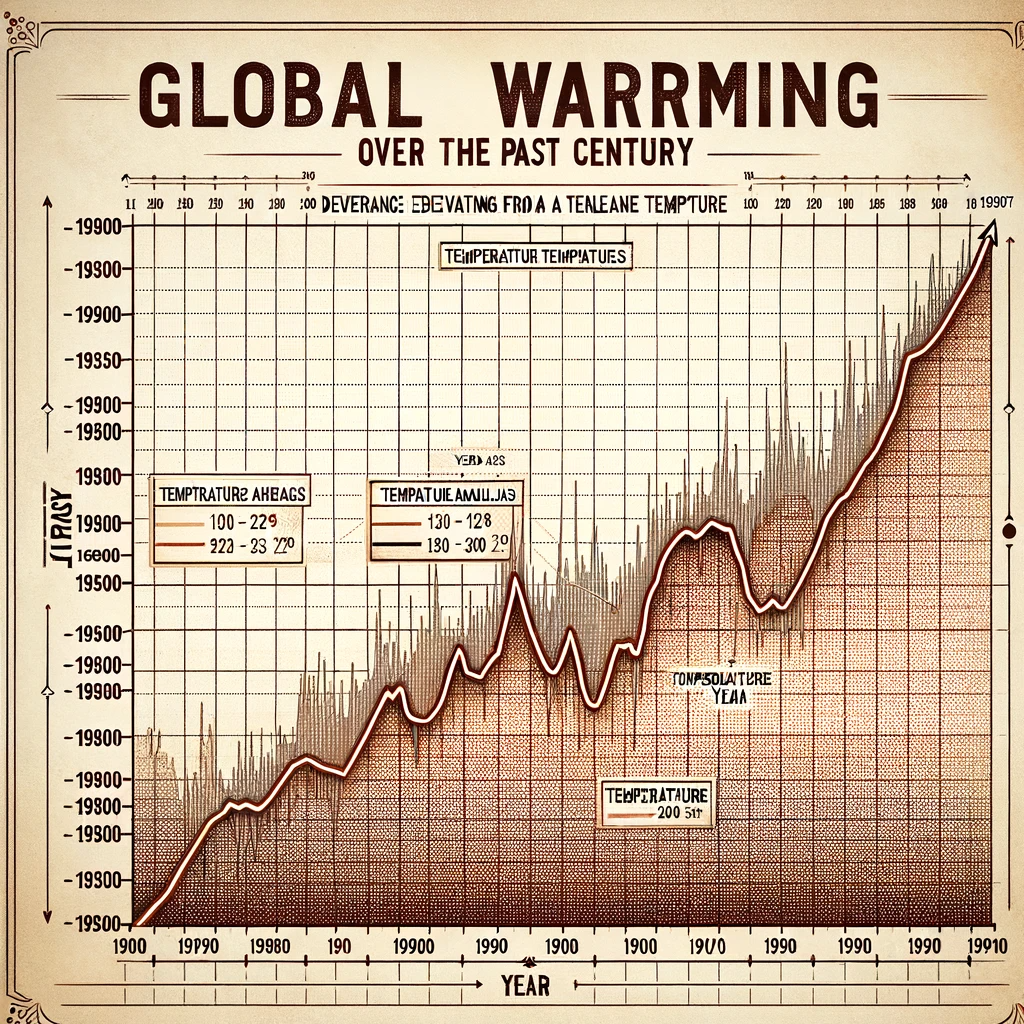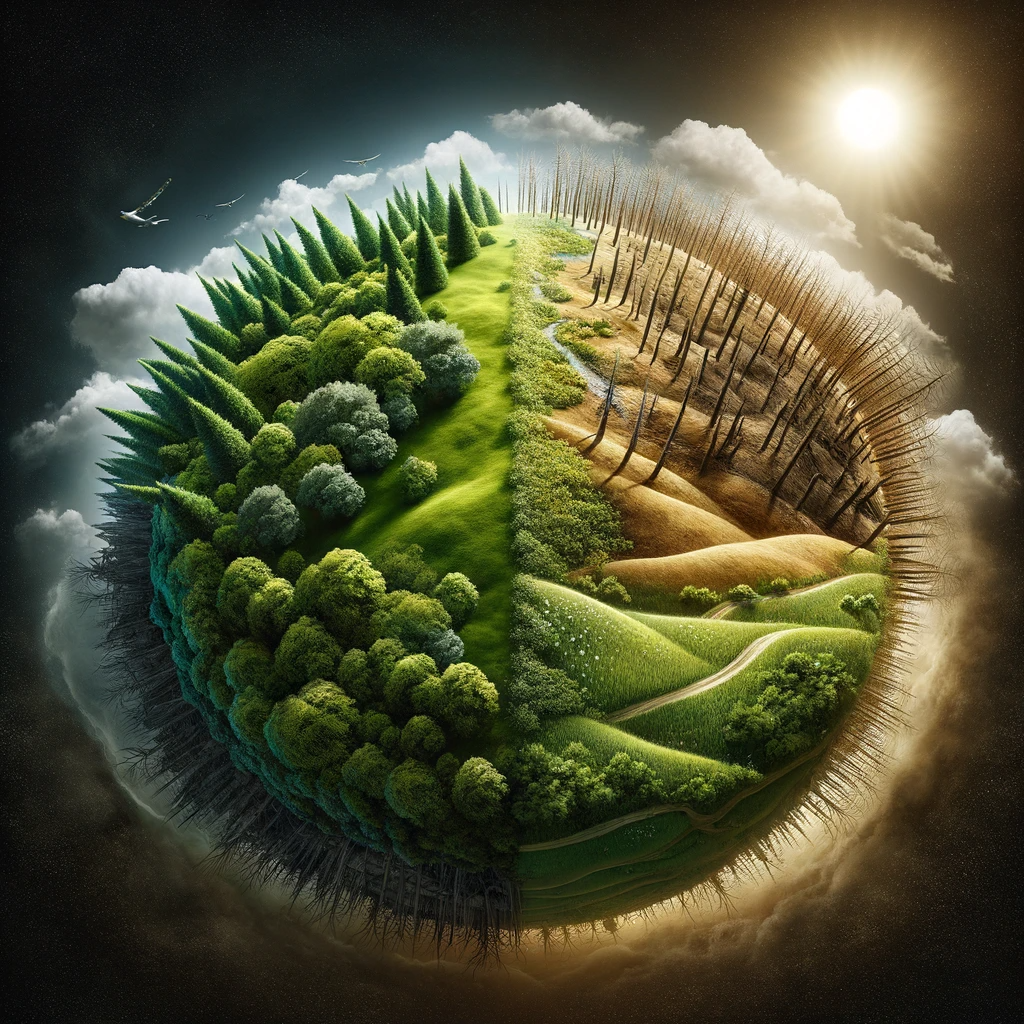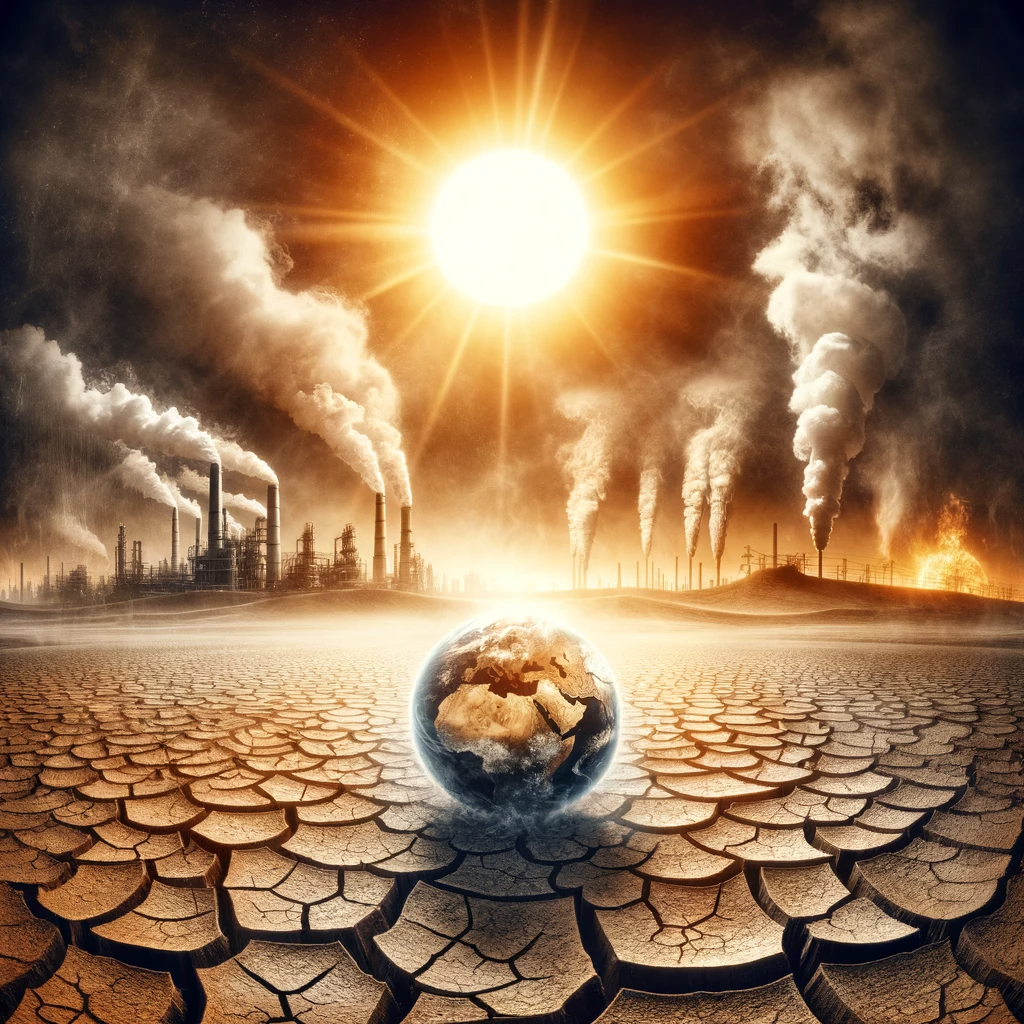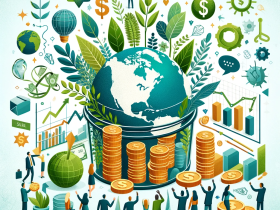Global warming refers to the long-term increase in Earth’s average surface temperature due to human activities, primarily the emission of greenhouse gases like carbon dioxide, methane, and nitrous oxide. These gases trap heat in the atmosphere, leading to a variety of changes in the Earth’s climate system. Some key aspects of global warming include:
- Rising Temperatures: One of the most direct effects of global warming is the increase in both land and ocean temperatures. This leads to more frequent and severe heat waves.
- Melting Ice and Glaciers: Higher temperatures cause polar ice caps, glaciers, and permafrost to melt, contributing to rising sea levels.
- Rising Sea Levels: The melting of ice and the expansion of seawater as it warms contribute to rising sea levels, which can lead to coastal flooding and erosion.
- Changes in Weather Patterns: Global warming affects weather patterns, leading to more extreme weather events such as hurricanes, droughts, heavy rainfall, and snowstorms.
- Impact on Ecosystems: Flora and fauna are impacted as their habitats change. Some species may become extinct if they cannot adapt quickly enough.
- Ocean Acidification: Increased levels of carbon dioxide in the atmosphere also lead to higher CO2 levels in oceans, causing them to become more acidic. This affects marine life, particularly organisms with calcium carbonate shells or skeletons.
Global warming is a complex issue that poses significant challenges to the environment, human health, and economies worldwide. It is a central aspect of broader climate change discussions and requires concerted global action to mitigate its effects and adapt to changes that are already underway.
Table of Contents
What are 5 effects of global warming?
Global warming has a wide range of effects on the Earth’s climate, ecosystems, and human societies. Five notable effects of global warming include:
- Increased Temperatures: The most direct effect of global warming is the rise in average temperatures around the world. This leads to more frequent and intense heatwaves, which can have severe health impacts and affect agriculture and ecosystems.
- Melting Polar Ice and Glaciers: Higher global temperatures cause the polar ice caps and glaciers to melt at an accelerated rate. This melting contributes to rising sea levels and affects the habitats of various polar species.
- Rising Sea Levels: As polar ice melts and warmer temperatures cause seawater to expand, sea levels rise. This can lead to coastal flooding, loss of coastal habitats, and can impact millions of people living in low-lying areas.
- Extreme Weather Events: Global warming is associated with an increase in the frequency and severity of extreme weather events. This includes more intense hurricanes and typhoons, heavier rainfall and flooding, more severe droughts, and increased wildfire risks.
- Changes in Ecosystems and Wildlife: Global warming affects ecosystems and wildlife, leading to changes in species distributions, migration patterns, and the timing of seasonal events. Some species may face increased risk of extinction if they cannot adapt quickly enough to the changing conditions.
These effects are interconnected and pose significant challenges to the environment, health, and economies globally. They highlight the importance of addressing global warming through mitigation and adaptation strategies.
What are the 5 main causes of global warming?
The main causes of global warming are primarily related to human activities that increase the concentration of greenhouse gases in the Earth’s atmosphere. These gases trap heat, leading to a rise in global temperatures. The five main causes are:
- Burning of Fossil Fuels: This is the most significant source of greenhouse gases. Burning coal, oil, and natural gas for energy and transportation produces large amounts of carbon dioxide (CO2) and other greenhouse gases.
- Deforestation: Trees absorb CO2, one of the primary greenhouse gases. When forests are cut down for timber or to make way for agriculture (like cattle ranching and palm oil plantations), this carbon sink is reduced, and the CO2 stored in trees is released into the atmosphere.
- Industrial Processes: Many industrial activities emit greenhouse gases. This includes the production of cement, steel, and chemicals, which often involve processes that release CO2 and other gases.
- Agriculture: Agricultural practices contribute significantly to global warming. Livestock such as cows produce methane (CH4), a potent greenhouse gas, through their digestive processes. Additionally, certain farming practices can release nitrous oxide (N2O), another powerful greenhouse gas.
- Waste Management: Landfills produce methane as organic waste decomposes. Inadequately managed waste disposal and treatment can thus be a significant source of greenhouse gas emissions.
These activities have increased the concentration of greenhouse gases in the atmosphere to levels not seen in at least 800,000 years, leading to the warming of the planet and the subsequent climatic changes we are witnessing today. Reducing these emissions is critical to mitigating the impacts of global warming.
What is global warming and its problems?
Global warming refers to the long-term increase in Earth’s average surface temperature, primarily due to the emission of greenhouse gases from human activities. This warming has numerous and significant impacts on the planet’s climate, ecosystems, and human societies. Here are some of the key problems associated with global warming:
- Climate Change: Global warming leads to widespread changes in weather patterns, resulting in more extreme and unpredictable weather. This includes more severe storms, droughts, heat waves, and heavy rainfall.
- Rising Sea Levels: As global temperatures rise, polar ice caps and glaciers melt, and seawater expands, leading to rising sea levels. This can cause coastal erosion, increased flooding, and can threaten low-lying islands and coastal communities.
- Impact on Ecosystems: Many species of plants and animals struggle to survive in changing climates. Altered habitats and shifting temperature ranges can lead to shifts in species distributions, disruption of food webs, and potential mass extinctions.
- Agricultural Impact: Changes in temperature and precipitation patterns can affect crop yields. Some regions may experience reduced agricultural productivity, leading to food shortages and increased prices.
- Health Risks: Global warming can exacerbate health issues. Increased heat can lead to more heat-related illnesses and deaths. Changes in climate can also affect air quality and the spread of disease-carrying organisms like mosquitoes, leading to the spread of diseases like malaria and dengue fever.
- Economic Consequences: The effects of global warming can have significant economic impacts. Costs associated with damage from extreme weather events, loss of productivity in agriculture, and health-related expenses can be substantial.
- Social and Political Impact: The consequences of global warming can lead to social and political challenges, including increased migration as people flee areas that become uninhabitable due to rising sea levels or severe droughts.
Global warming is a complex issue that requires coordinated global action to reduce greenhouse gas emissions and to adapt to the changes that are already underway.
What is global warming short essay?
Global warming is a critical environmental challenge facing the world today. It refers to the ongoing rise in the average temperature of the Earth’s climate system, a phenomenon that is predominantly driven by human activities. This essay provides a concise overview of global warming, its causes, impacts, and potential solutions.
At the heart of global warming is the enhanced greenhouse effect, primarily caused by the burning of fossil fuels such as coal, oil, and natural gas. These activities release significant amounts of greenhouse gases, particularly carbon dioxide (CO2), into the Earth’s atmosphere. These gases trap heat from the sun, leading to an increase in global temperatures. Other human activities contributing to global warming include deforestation, industrial processes, and certain agricultural practices, all of which exacerbate the accumulation of greenhouse gases.
The consequences of global warming are widespread and alarming. They include rising sea levels due to the melting of polar ice caps and glaciers, more frequent and severe weather events like hurricanes and heat waves, and significant changes in precipitation patterns. These changes have profound effects on natural ecosystems, leading to loss of biodiversity and shifts in wildlife populations and habitats. Moreover, global warming poses serious risks to human health, agriculture, water resources, and economies, particularly in vulnerable regions of the world.
Addressing global warming requires a multifaceted approach. This includes reducing greenhouse gas emissions through transitioning to renewable energy sources, enhancing energy efficiency, and promoting sustainable land use practices. International cooperation is crucial, as evidenced by agreements like the Paris Climate Accord. Adaptation strategies are also vital, as some impacts of global warming are already unavoidable. These strategies include developing resilient infrastructure, protecting coastal communities, and investing in climate-resilient agriculture.
Global warming is a complex challenge with far-reaching impacts. It necessitates prompt and concerted efforts at individual, local, national, and global levels to mitigate its effects and to adapt to its inevitable consequences. The choices and actions taken today will determine the severity of its impact on future generations.
What are 10 ways to reduce global warming?
Combating global warming requires a collective effort from individuals, communities, businesses, and governments. Here are 10 ways to help reduce global warming:
- Reduce, Reuse, Recycle: Adopting these three Rs in daily life can significantly lower greenhouse gas emissions. This includes recycling paper, glass, plastic, and metal, and reducing waste by reusing items and buying products with minimal packaging.
- Use Energy Efficiently: Upgrade to energy-efficient appliances and light bulbs. Implementing smart power strips and maintaining heating and cooling systems can also reduce energy consumption.
- Support Renewable Energy: Opt for renewable energy sources such as solar, wind, or hydroelectric power for your home or community. Supporting policies and companies that invest in renewable energy also helps.
- Conserve Water: Using water efficiently helps reduce the energy required to process and deliver it, thus reducing greenhouse gas emissions. Simple steps include fixing leaks, using water-saving fixtures, and reducing water wastage.
- Green Transportation: Reduce your carbon footprint by using public transportation, carpooling, biking, walking, or driving fuel-efficient vehicles. Electric cars and hybrids are good options for reducing emissions.
- Plant Trees and Maintain Green Spaces: Trees absorb CO2, helping to mitigate climate change. Planting trees and maintaining gardens and parks can significantly impact carbon sequestration.
- Eat a Low-Carbon Diet: Eating more plant-based foods and reducing meat consumption, especially beef and lamb, can lower the carbon footprint. Also, reducing food waste and buying local produce helps.
- Advocate and Educate: Spread awareness about global warming and advocate for policies that reduce greenhouse gas emissions. Educating others and supporting climate change initiatives can have a large-scale impact.
- Support Sustainable Practices: Choose products and services from companies that prioritize sustainability. This includes products with minimal packaging, sustainably sourced materials, and ethical business practices.
- Personal Carbon Offsets: Invest in carbon offsetting projects, such as renewable energy, reforestation, or energy efficiency projects, to compensate for the emissions you cannot eliminate.
Each of these actions, while seemingly small on an individual level, can collectively lead to significant reductions in greenhouse gas emissions and help mitigate global warming.
Examples of global warming
Global warming, the gradual increase in Earth’s average surface temperature, manifests in various ways across the globe. Here are some notable examples:
- Rising Global Temperatures: One of the most direct signs of global warming is the consistent rise in average global temperatures. The past decades have repeatedly been among the warmest on record since modern temperature monitoring began.
- Melting Ice Caps and Glaciers: Polar regions, particularly the Arctic and Antarctic, have shown significant ice melt. Glaciers around the world, from the Himalayas to the Andes, are retreating at unprecedented rates.
- Rising Sea Levels: As a result of melting ice and the expansion of seawater as it warms, global sea levels are rising. This leads to coastal erosion, increased flooding, and threatens low-lying areas and island nations.
- Increased Frequency of Heatwaves: Many regions are experiencing more frequent and intense heatwaves, leading to health emergencies, increased energy demand, and agricultural stress.
- Changing Precipitation Patterns: Altered weather patterns due to global warming result in changes in rainfall. Some areas experience increased heavy rainfall and flooding, while others face severe droughts.
- More Intense and Frequent Extreme Weather Events: There is an increase in the frequency and intensity of extreme weather events such as hurricanes, typhoons, and cyclones, which are becoming more powerful and destructive.
- Ocean Acidification: The oceans absorb a significant amount of CO2 from the atmosphere, leading to ocean acidification. This affects marine ecosystems, particularly coral reefs and shellfish.
- Shifts in Wildlife Populations and Behavior: Many animal and plant species are shifting their ranges towards the poles or to higher elevations in response to changing temperatures. Phenological changes, like earlier blooming of plants and breeding of animals, are also observed.
- Impacts on Agriculture: Global warming affects crop yields with changing rainfall patterns, droughts, and heat stress. Some areas may see reduced agricultural productivity.
- Retreating Snow Cover: Snow cover in many regions, particularly in the Northern Hemisphere, is decreasing, affecting water resources and ecosystems.
These examples illustrate the wide-ranging impacts of global warming, affecting every part of the globe in various ways. The urgency to address this global issue is highlighted by these diverse and profound effects.
A Chart table for global warming
Here’s a chart table summarizing various aspects of global warming and their descriptions:
| Aspect of Global Warming | Description |
|---|---|
| Increased Average Temperatures | Rise in land and ocean temperatures leading to heatwaves. |
| Melting Ice Caps and Glaciers | Reduction in polar ice and glaciers, affecting habitats and sea levels. |
| Rising Sea Levels | Oceans expand and ice melts, increasing flood risks in coastal areas. |
| Extreme Weather Events | More frequent and severe storms, droughts, and hurricanes. |
| Changing Ecosystems | Shifts in habitats and species extinction due to temperature changes. |
| Ocean Acidification | Increased CO2 levels lead to more acidic oceans, affecting marine life. |
| Agricultural Impacts | Changes in crop yields due to altered weather patterns and extreme conditions. |
| Health Risks | Increased incidences of heat-related illness and spread of diseases. |
| Economic Consequences | Costs related to damage from natural disasters and adaptation measures. |
| Energy Demand | Higher temperatures lead to increased energy use for cooling. |
This table provides an overview of the diverse impacts of global warming, highlighting the multifaceted nature of this global challenge.
A Graph sheet picture of global warming

Here is a graph depicting global warming trends over the past century. This graph illustrates the steady increase in average global temperatures, providing a clear visual representation of the trend of global warming.
List of worldwide Top 10, agencies work for global warming including web Address
Here’s a list of notable organizations and agencies around the world that are actively working on addressing global warming and climate change, along with their respective websites:
Wine To Water: Focused on providing clean water and conducting environmental sustainability programs, with efforts spanning various countries. Website: https://www.wtw.org/
Protect Our Winters (POW): Aims to protect nature-oriented lifestyles from climate change, leveraging a community of athletes, scientists, and business leaders. Website: https://protectourwinters.org/
NatureBridge: Provides educational programs in national parks to inspire young people towards environmental stewardship. Website: https://naturebridge.org/
Southern Environmental Law Center (SELC): A nonpartisan environmental legal advocacy organization focused on the South, dealing with climate justice and public health. Website: https://www.southernenvironment.org/
Yellowstone Forever: Official nonprofit partner of Yellowstone National Park, dedicated to protecting and enhancing the park’s environment. Website: https://forever.yellowstone.org/
Catalyst Miami: Works on climate resilience and protection for low-income communities in Miami-Dade County, Florida. Website: https://www.catalystmiami.org/
Climate Emergency Fund: Provides funding to activists and organizations in the U.S. to raise awareness of global warming and environmental change. Website: https://www.climateemergencyfund.org/
Earth Guardians: Focuses on environmental leadership and advocacy training for youth, including diverse forms of media outreach. Website: https://www.earthguardians.org/
Container Recycling Institute: Advocates for effective recycling systems and policies to reduce waste and resource depletion. Website: https://www.container-recycling.org/
5 Gyres Institute: Addresses plastic pollution in oceans and supports legislation to reduce plastic use and promote recycling. Website: https://www.5gyres.org/
These organizations represent a diverse range of approaches and geographical focuses in the fight against global warming, from legal advocacy and policy influence to education and direct community action. Each plays a vital role in addressing the multifaceted challenges of global warming.

Conclusion
Global warming represents one of the most pressing and complex challenges facing the world today. It is characterized by a long-term rise in the average temperature of the Earth’s atmosphere and oceans, driven predominantly by human activities, especially the burning of fossil fuels and deforestation. The consequences of global warming are extensive and multifaceted, affecting the natural environment, human health, economic stability, and social structures.
Key impacts of global warming include increased frequencies of extreme weather events, rising sea levels, melting glaciers and ice caps, changes in agricultural productivity, and loss of biodiversity. These effects have far-reaching implications for ecosystems, water resources, food security, and human livelihoods.
Addressing global warming requires coordinated global action and a multi-pronged approach. This includes reducing greenhouse gas emissions through the adoption of renewable energy sources, enhancing energy efficiency, and promoting sustainable land use and agricultural practices. International cooperation, as seen in agreements like the Paris Climate Accord, is crucial in this effort.
Moreover, adaptation strategies are essential to manage the impacts of climate change that are already occurring. These strategies range from building climate-resilient infrastructure to developing adaptive agricultural systems and protecting vulnerable communities.
The fight against global warming is not just a matter of environmental conservation; it is essential for the sustainability of human civilization itself. It calls for a collective effort from individuals, communities, businesses, and governments worldwide. The actions and policies implemented today will have lasting implications for future generations, underlining the urgent need for immediate and sustained action in addressing this global crisis.
Frequently Asked Questions (FAQs) about global warming
Here are some frequently asked questions about global warming, along with summarized answers:
Why is CO2 the main focus when other heat-trapping gases exist?
CO2 gets the most attention because it contributes the most to climate change between 1750 and 2011. It’s the largest climate change driver, primarily due to the burning of fossil fuels like coal, oil, and gas, as well as deforestation. While other gases like methane are more effective at trapping heat, they are less abundant in the atmosphere compared to CO2.
How does air pollution affect global warming?
Air pollution, specifically aerosols (tiny particles in the atmosphere), has a measurable effect on global warming. They can reflect or absorb solar energy, and historically, they have partially offset the rise in global mean surface temperature. However, the accumulated heat-trapping gases in the atmosphere will overpower any temporary cooling due to aerosols.
How does the sun affect our climate?
The sun is the primary energy source that drives biological and physical processes on Earth. While changes in solar intensity over millions of years can influence climate, such as ice ages, changes in solar output in the last century cannot account for the magnitude and distribution of the rise in global mean temperature.
Is there a connection between the ozone layer hole and global warming?
While they are different issues, both the depletion of the ozone layer and global warming are caused by human activities releasing gases that alter the atmosphere. The ozone layer absorbs harmful UV radiation, whereas greenhouse gases trap heat in the Earth’s atmosphere.
How is climate change affecting the ocean and agriculture?
Climate change is causing oceans to warm, which affects marine life and ecosystems. Warmer oceans drive fish migrations, contribute to coral bleaching, and impact the marine food chain. It also makes oceans more acidic, threatening marine habitats, especially shellfish. In agriculture, climate change disrupts weather patterns, leading to more extreme weather events, impacting crop yields and increasing the prevalence of pests.
Do deforestation and agriculture contribute to climate change?
Yes, deforestation, land use changes, and agricultural emissions account for about a quarter of heat-trapping gas emissions from human activities. This includes methane from livestock, nitrous oxide from fertilizers, and carbon dioxide from deforestation and land use changes.
What are the solutions to climate change?
Solutions include reducing heat-trapping gas emissions, sustainable land management, climate-smart agricultural practices, and utilizing natural carbon storage like forests. Technological advancements, policy changes, and individual actions also play a crucial role in addressing climate change.
These FAQs provide a basic understanding of the complexities and impacts of global warming, as well as potential strategies for mitigation and adaptation. For more detailed information, you can visit the sources linked.









Leave a Reply